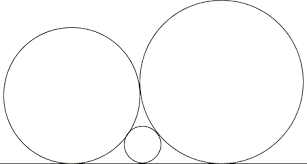Circles and Circles
Let Circle A be external tangent to Circle B. Let Circle C be external tangent to both Circle A and B. All three circles are external tangent to a line. Prove that for any given radius of Circle A and B, for example, x and y, respectively, the radius of the Circle C with radius z can be expressed as [1/sqrt(x)]+[1/sqrt(y)]= [1/sqrt(z)]
 (Google Images)
(Google Images)
No vote yet
1 vote
Easy Math Editor
This discussion board is a place to discuss our Daily Challenges and the math and science related to those challenges. Explanations are more than just a solution — they should explain the steps and thinking strategies that you used to obtain the solution. Comments should further the discussion of math and science.
When posting on Brilliant:
*italics*or_italics_**bold**or__bold__paragraph 1
paragraph 2
[example link](https://brilliant.org)> This is a quote# I indented these lines # 4 spaces, and now they show # up as a code block. print "hello world"\(...\)or\[...\]to ensure proper formatting.2 \times 32^{34}a_{i-1}\frac{2}{3}\sqrt{2}\sum_{i=1}^3\sin \theta\boxed{123}Comments
Use descartes' circle theorem.
Log in to reply
Any other way?
Log in to reply
Here's another way.
We first prove the following lemma:
Using this lemma, we get the following proof:
Log in to reply
@Raymond Park Was this helpful?
Log in to reply
Well done!